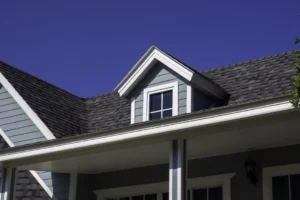Are you having trouble with a sagging roof?
Does it need some repairs?
Don’t worry! Fixing a sagging roof isn’t as difficult as it seems.
With the right supplies and knowledge, anyone can restore their roof to its former glory!
First, let’s examine what causes roofs to sag in the first place. Common culprits are water damage from storms or leaks; weak rafters due to old age; and inadequate support structures that weren’t built correctly. Knowing which of these is causing your issue will help determine the best way to fix it.
Finally, we’ll go over all the materials and steps needed for successful repair work on your home’s roof. From shoring up support beams and replacing missing tiles to patching holes and adding insulation, we’ll make sure you have everything covered so you can get back out there confidently tackling those pesky problems!
What Are The Factors Of Roof Sagging?
Roofs can sag for a variety of reasons. Some common causes include: age, inadequate support from the rafters, and water damage from rain or snow. Age is one of the primary causes of roof sagging. As the time passes, a roof normally gets exposed to harsh weather conditions such as temperature changes, high wind and hail storms. As this deterioration occurs, it weakens the structure of the roof which leads to its eventual collapse. Inadequate support from rafters can also be an issue for older homes; if the rafters weren’t built with enough strength to bear the weight of the roof materials over time they may start to bend under pressure causing them to give way and cause sagging in certain areas. Finally, water damage caused by heavy rainfall or snow accumulation can weaken wood framing materials leading to compromised structural integrity that eventually results in roof sagging.
Water Damage
Transitioning from the previous section, water damage is one of the main causes of roof sagging. Water damage can come in many forms and should be checked for regularly by a professional.
There’s also a major concern that goes undetected with water seepage which is the structural damage it can cause to your existing home’s foundation. Unaddressed water leakage can lead to wood rot, mold growth and even more costly repairs down the road. It is important that you check for any signs of water infiltration at least twice per year during spring and fall maintenance checks.
Inspectors should also look for missing shingles or tiles, loose flashing around vents and chimneys, clogged gutters which could cause standing water on the roof, damaged skylights or other openings where moisture may enter your rooftop. If left unchecked or if you don’t hire a professional to perform a roofing inspection any time soon, these issues can cause a significant problem in the future.
Bad Material Or Poor Installation
In many cases, a sagging roof is the result of bad material or poor installation.
If you’ve a roofing material which is of low quality, it is always best to replace them with new and robust material. Changing roof material may require you to replace the shingles as these parts are more commonly deteriorated because of wind or hail damage. In cases where the damage is done to a significant extent, your property might require complete re-roofing which can be an extensive project and can cost you a good investment.
On the other hand, if it was poorly installed in the first place, then simply repairing and reinforcing existing materials should do the trick. You can use extra nails on each shingle to secure them better; this will help prevent them from coming loose over time due to weather conditions like heavy winds or rain. Additionally, be sure that all seams are properly sealed with caulk and that flashing around chimneys and skylights has been adequately applied for maximum protection against water damage. Taking these steps should help ensure your roof remains firmly in place for years to come!
Age Of The Roof
Just like bad material or poor installations, determining the age of the roof is just as important.
A newer roof will generally be more resilient than an older one, and may require fewer repairs or even no repair at all. Sometimes, the roof is just quite too old and may have subjected to many other problems such as hail storms, snow falls, heavy winds or simply, the general wear and tear. These type of problems may often require repairs that are not that heavy on the pockets but are just as essential.
If you suspect that your roof may need work due to its age, contact a professional immediately for an inspection. An experienced contractor can assess the extent of damage and recommend appropriate measures for fixing the problem. In many situations, a roofing contractor will ask you to replace the damaged parts like shingles or tiles with brand new ones. There are also other factors such as condition of the material which was used to build the roof or the extent of damage. Although it can be solved with minor patchwork or reconstructing a part of the entire roof, it’s always best to get expert opinion.
Important Facts About A Sagging Roof
1. It is likely necessary to replace some shingles if the sagging is more than an inch.
2. It may be time to get a new roof if the sagging has been going on for a while.
3. Low spots on a roof are typically the result of insufficient insulation and ventilation at the upper edge of the roof.
4. A new ridge vent or chimney stack cap may be needed to prevent water from entering the home if the roof is sagging.
5. A sagging roof is typically identified by a 2-inch gap between shingles and daylight visible through that opening.
6. Weak or rotten roof trusses often cause roofs to sag.
7. The best way to avoid roof sagging is to properly maintain it and fix any damage promptly.
How Experts Repair A Sagging Roof?
Experts use a few different methods to repair a sagging roof. The first step is to identify the root of the problem, which may be caused by issues such as rotting rafters or weakened framing. If this is the case, then it’s important for an expert to strengthen and reinforce these areas with additional support beams that can help redistribute weight evenly across the structure. Additionally, they must inspect all other parts of the roofing system including fascia boards, flashing and gutter systems in order to make sure everything else is functioning properly.
In some cases, experts might recommend replacing existing shingles if they are too old and unable to withstand heavy loads over time. They also need to check for any damage from water leakage or mold growth due to improper ventilation. Finally, once all repairs have been made, an experienced professional should seal up any gaps between eaves and walls in order to prevent future problems from occurring. With regular maintenance checks and proper care, your roof will stay strong for years to come!
How To Identify The Extent Of Damage
The first step in fixing a sagging roof is to identify the extent of damage. To do this, you’ll need to take some measurements and inspect the area closely. The best way to measure the sag is by using a level or measuring tape across the length of the roofing system where it is showing signs of distress. Make sure that your measurements are taken from an even surface such as ground level or on top of a ladder.
Once you have your measurement, compare it with what should be expected for that type of roofing system. If there is more than one inch difference between what has been measured and what should be expected, then further investigation will likely be needed. In addition, make sure to check for any other visible signs of damage such as broken shingles, cracked tiles, loose seams, etc., which could indicate underlying problems with the structure itself.
Conclusion
Now that you have identified the extent of damage to your roof, it’s time to take action. Depending on the severity and type of damage, there are a few ways you can fix your sagging roof. If there is only a minor amount of damage, simply replacing any missing shingles or tiles may do the trick. Additionally, adding additional supports along weak spots in the trusses will help add strength and support back into the roof structure.
If more significant repairs need to be made due to rot or decay, then replacing parts of your roof such as rafters or entire sections of trusses may be necessary. In these cases, hiring professional help is recommended since they have experience with this kind of repair work and know exactly how to go about fixing a sagging roof safely and effectively. Being proactive and taking care of the problem before you end up paying for an entire roof replacement will not only save you money but also secure your home for years to come.








